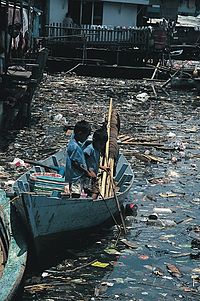
Photo from wikipedia
Seawater and fish were collected from nearshore (Pearl River Estuarine, PRE) and offshore (middle of the South China Sea, MSCS) regions of the South China Sea (SCS) to determine the… Click to show full abstract
Seawater and fish were collected from nearshore (Pearl River Estuarine, PRE) and offshore (middle of the South China Sea, MSCS) regions of the South China Sea (SCS) to determine the heavy metals (HMs) pollution status and biomagnification characteristics. Results show that Cu in PRE seawater was moderately contaminated. Overall pollution risk of seawater were PRE (3.32) > MSCS (0.56), whereas that of fish was MSCS (0.88) > PRE (0.42). δ13C and δ15N exhibited distinguished characteristics for PRE and MSCS fish, indicating the diverse energy sources, nitrogen sources, and food web structures of nearshore and offshore regions. Cu was biomagnified whereas Pb and Ni were biodiluted in offshore fish. Hg presented significant biomagnification in both of nearshore and offshore fish. Finally, the target hazard quotient of Hg (1.41) in MSCS fish exceeded the standard limit, which was posed by high Hg concentration and consumption rate of offshore fish.
Journal Title: International Journal of Environmental Research and Public Health
Year Published: 2022
Link to full text (if available)
Share on Social Media: Sign Up to like & get
recommendations!